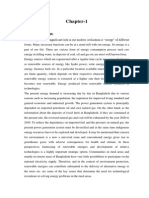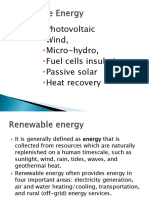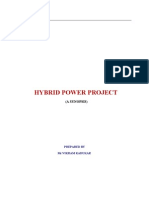306 Electricity Supply Industry
306 Electricity Supply Industry
Uploaded by
Mani KandanCopyright:
Available Formats
306 Electricity Supply Industry
306 Electricity Supply Industry
Uploaded by
Mani KandanOriginal Title
Copyright
Available Formats
Share this document
Did you find this document useful?
Is this content inappropriate?
Copyright:
Available Formats
306 Electricity Supply Industry
306 Electricity Supply Industry
Uploaded by
Mani KandanCopyright:
Available Formats
306
ELECTRICITY SUPPLY INDUSTRY
ELECTRICITY SUPPLY INDUSTRY
Electricity plays a vital role in our society. In the United States alone, retail electricity sales reached $200 billion in 1994. The electricity industry performs three primary functionsgeneration, transmission, and distribution. Some utilities are engage in all three functions, whereas others specialize in one or two functions. Generation is the process of producing electricity. In 1994 US electric utilities produced 2.9 trillion kWh of electricity. It was produced using 56% steam-driven generators fueled by coal, 3% steam-driven generators fueled by oil, 9% steamdriven generators fueled by natural gas, 9% renewable resource generators, 1% gas turbine or internal combustion generators, and 22% nuclear generators. In addition, renewable energy resources represent primarily hydroelectric, biomass, geothermal, solar thermal, photovoltaic, wind, and ocean. Transmission is the process of conducting the ow of electricity at high voltages from the points of generation to the locations of electricity consumption such as residential, industrial parks, and commercial centers. The transmission system consists of transmission lines, substations, voltage transformers, and circuit breakers. Electricity transmission involves xed costs associated with obtaining rights of way. Distribution is divided into two functionsdelivery and retail sales. Delivery of electricity is the process of transforming high-voltage electricity to lower voltages and then physically delivering it to households, industrial facilities, and commercial establishments. Retail sales of electricity is the process of marketing electricity to customers. Physical distribution of electricity involves large xed costs for capital amenable to competition. There are different types of generating companies with their own generating capacity and share of nal sales; some are owned by investors, whereas the others are publicly owned, rural electric cooperatives, and federally owned utilities. The US electricity industry began as an unregulated private enterprise in 1882. Then in 1907 the states began to regulate electric utilities. In 1935 the Public Utilities Holding Company Act (PUHCA) transformed the multistate and complex holding companies into simple corporate structure subject to regulation by state authorities. PUHCA granted the Securities and Exchange Comission (SEC) broad power to conne acquisition of assets to geographically dened areas and to functions related to utility operations. PUCHA also has a responsibility for controlling the utilities corporate structures. The use of atomic energy to produce electricity
started in 1950. At that time, privately owned utilities were fully under the control of state public utility commissions, the SEC, and the Federal Public Commission (FPC). In 1950 average electricity rates fell from 3/kWh to 2.5/ kWh for residential customers, and demand for electricity grew at twice the annual rate as the national economy. In 1965 the system suffered the great Northeast blackout. The utility industry responded by forming the North American Electric Reliability Council (NERC) charged with keeping electricity service reliable. In 1992 the Energy Policy Act started to widen access to the transmission grid. In 1994 California proposed to allow competition at retail level by 2003. In 1996 the Federal Energy Regulatory Council (FERC) issued Order 888, which specied conditions under which all utilities must provide such access to the US transmission system. ENERGY SOURCES Nonrenewable Energy Sources Nonrenewable energy sources are coal, oil, natural gas, and nuclear energy. In 1990 oil provided about 41% of the worlds energy derived from nonrenewable sources; coal provided about 29%; natural gas, 23%; and nuclear energy, 6%. 1. Oil is the worlds most widely used fuel; the total usable energy contained in the worlds oil reserves is about one sixth of the coal reserve. 2. Coal is the worlds most abundant nonrenewable energy source. Coal is the least expensive of fossil fuels and is widely burned for domestic and industrial heat and electric power generation. Coal was the industrial worlds main energy source until the early 1960s, when the availability of inexpensive oil and the growing use of liquid fuels for transportation made oil the dominant fuel. During the 1970s, the rapid increases in the price of oil brought about a modest worldwide return to coal for heating and electric power generation. However, oil has remained the leading energy source. 3. Natural gas is not as abundant as coal. The energy content of the worlds natural gas reserves is comparable to that of oil. Methane, which is the major constitute of natural gas, burns easily and can be untreated as an industrial or domestic heating fuel. However, when compared to oil, methane has a few signicant disadvantages, which have tended to limit its use. 4. Nuclear energy is produced by nuclear power plants through a process known as nuclear ssion. Here a freemoving atomic particle called a neutron collides with the nucleus of an atom and causes it to split apart. During ssion, a portion of the split atoms mass is converted into energy. Nuclear ssion produces additional free neutrons, which can split other atoms in a chain reaction. Renewable Energy Sources Hydropower. Hydropower converts the energy in owing water into electricity. The quantity of electricity generated is determined by the volume of water ow and the amount of head, the height from turbines in the power plant to the wa-
J. Webster (ed.), Wiley Encyclopedia of Electrical and Electronics Engineering. Copyright # 1999 John Wiley & Sons, Inc.
ELECTRICITY SUPPLY INDUSTRY
307
ter surface created by the dam. The greater the ow and head, the more electricity is produced. With a capacity of more than 92,000 MW (enough electricity to meet the energy needs of 28 million households), the United States is the worlds leading hydropower producer. Hydropower supplies 49% of all renewable energy used in the United States. Biomass Energy. Biomass energy (the energy contained in plants and organic matter) is one of the most promising renewable energy technologies. Instead of conventional fuels, the technology uses biomass fuels (agricultural residues, or crops grown specically for energy production) to power electric generators. Today, biomass energy account for nearly 45% of renewable energy used in the United States. Biomass is used to meet a variety of energy needs, including generating electricity, heating homes, fueling vehicles, and providing process heat for industrial facilities. In the last few decades, biomass power has become the second largest renewable source of electricity after hydropower. Hydropower and biomass plants provide baseload power to utilities. Biomass power plants are fully dispatchable (i.e., they operate on demand whenever electricity is required). About 350 biomass power plants with a combined rated capacity of 7000 MW feed electricity into the nations power lines, whereas another 650 enterprises generate electricity with biomass for their own use as cogenerators. National Renewable Energy Laboratory (NREL) research has helped lower the cost of ethanol fuel from these sources to $1.22/gal. The target of current researches is 70/gal. Photovoltaic (PV) Systems. Most commonly known as solar cells, PV systems convert light energy into electricity. PV systems are already an important part of our lives. They are a popular means of powering small calculators and wrist watches. More complicated PV systems provide electricity for pumping water, powering communications equipment, and even lighting our homes and running our appliances. In a surprising and increasing number of cases, PV power is the cheapest form of electricity for performing many tasks. Costs have dropped from 90/kWh in 1980 to 22/kWh in the late 1990s. Photovoltaics are cost competitive in rural and remote areas around the world. The National Photovoltaics Center at NREL is leading federal efforts to improve performance and lower costs (110). Wind Power. Wind energy projects provide cost-effective and reliable energy in the United States and abroad. The US wind industry currently generates about 3.5 109 kWh of electricity each year, which is enough to meet the annual electricity needs of 1 million people. Wind energy installations are going up across the country as generating companies realize the benets of adding clean, low-cost, reliable wind energy to their resource portfolios. Solar Thermal Systems. Solar thermal electric (STE) technologies, which include parabolic troughs, power towers, and dish/engine systems, convert sunlight into electricity efciently and with minimum effect on the environment. These technologies generate high temperatures by using mirrors to concentrate the suns energy up to 5000 times its normal intensity. This heat is then used to generate electricity for a variety of market applications, ranging from remote power
needs as small as a few kilowatts up to grid-connected applications of 200 MW or more. Solar-thermal electricity provides electricity for grid-connected applications at the lowest price available today, and it has the potential for further, signicant cost reductions. Although not currently competitive for utility applications in the United States, the cost of electricity from STE can be competitive in international and domestic niche applications, where the price of energy is higher. The goal for advanced STE technologies is to be below 5/kWh. The United States annually uses more than 7.1 1013 Btu of solar energy (1.0 106 Btu equals 90 lb coal or 8 gal gasoline). The residential and commercial sectors use 6.0 1013 Btu, the industrial sector uses 1.1 1013 Btu, and utilities use 5.0 1011 Btus. Geothermal Energy. Geothermal energy is the heat contained below the Earths crust. This heat is brought to the surface as steam or hot watercreated when water ows through heated, permeable rockand used directly for space heating in homes and buildings or converted to electricity. Most of the countrys geothermal resources are located in the western United States. Currently, US geothermal power plants have a total generating capacity of 2700 MW, enough electricity to power the homes of more than 3.5 million people. The power plants produce electricity at 5/kWh to 7.5/kWh. The Geysers Power Plant in northern California, the worlds largest geothermal power plant, generates more than 1700 MW of electrical power, 7% of the total electricity Pacic Gas and Electric Company (PG&E) supplies to California. Ocean Thermal Energy. Ocean thermal energy conversion (OTEC) is an energy technology that converts solar radiation to electric power. OTEC systems use the oceans natural thermal gradientthe fact that the oceans layers of water have different temperaturesto drive a power producing cycle. OTEC systems can produce a signicant amount of power as long as the temperature between the warm surface water and the cold deep water differs by about 20C (36F). The oceans are thus a vast renewable resource, with the potential to help us produce 1013 W of electric power. The economics of energy production have delayed the nancing of OTEC plants. However, OTEC is very promising as an alternative energy resource for tropical island communities that rely primarily on imported fuel. Energy Storage Energy may be stored in a variety of forms, including thermal, electrical, mechanical, and chemical energy. Storage systems are a valuable addition to renewable energy facilities whose output is variable and sometimes difcult to predict. Adequate storage can help ensure that the intermittent output from solar and wind facilities is available when it is needed. For example, batteries have been used to provide energy storage for small photovoltaic arrays and wind turbines that have been installed at thousands of locations worldwide during the past 10 years. Energy storage can provide benets to utilities by bridging the gap between energy supply and demand and thereby using their generating capacity more efciently. Rather than cycling units on and off as demand uctuates, utilities can operate more of their units during the
308
ELECTRICITY SUPPLY INDUSTRY
day, storing surplus energy produced during hours of low demand and later using it when the demand increases. More details will be demonstrated in the next sections by an application to battery storage (3335). SHORT-TERM THERMAL GENERATION SCHEDULING In the electric power system, the load will be higher during the day and early evening and lower during the late evening and early morning. Also, the load is lower during weekend days than during weekdays. The problem in the electric power system is that we would like enough committed (turned on) units to supply the load while generation and operation costs are minimized. An available option is to apply augmented Lagrangian relaxation (11,12) to solve the thermal unit commitment problem. The production cost is calculated as the product of the units heat rate (MBtu/h) and fuel cost ($/MBtu) with an approximated cost function as a quadratic equation. The optimization problem has the following constraints. 1. According to system real power balance equation, generation should be equal to the load. 2. System spinning reserve should be sufcient to make up for a generation unit failure, and it should be spread around the system to avoid transmission limitations. 3. The transmission line capacity has limits. 4. There is a total emission limit. 5. Thermal unit limitations are represented by the following constraints: a. Minimum up timeOnce the unit is on-line, it should not be turned off immediately. b. Minimum down timeOnce the unit is decommited, there is a minimum time before it can be recommitted. c. Crew constraintsThe number of units that can be started up is limited by the number of crew members available. d. Ramp rate limitsThere are limits on the rate of change in power generation of each unit. e. Fuel constraintsSome units can burn only a limited amount of fuel in a given time, whereas other units must burn a specied amount of fuel in a given time. f. Minimum and maximum power generation for each unit (21,24). Short-Term Generation Scheduling in a Thermal-Photovoltaic Grid with Battery Storage We present an efcient approach to short-term generation scheduling for an integrated thermal and photovoltaic battery generation. The proposed model incorporates battery storage for peak load shaving. Several constraints including battery capacity, minimum up/down time and ramp rates for thermal units, as well as natural photovoltaic capacity are considered in the proposed model. A case study composed of 26 thermal units and a PVbattery plant is presented to test the efciency of the method (1315).
Ppv PV generator Ps
Controller Pb Battery
= ~ Inverter Battery Charger Synchronization
Thermal unit Pt Pu
Load
Figure 1. PV-utility grid with battery storage.
Problem Formulation. The PV utility uses the energy generated by PV plants to minimize the cost of operating thermal units. Figure 1 presents an example of a PV-utility system; the PV system may be spread out over a large geographical area with the battery in a centralized location. The intermittent nature of a PV system adds a signicant variance to the thermal generation of a power system. For secure operation, utilities have traditionally planned for normal load uctuations and sudden loss of the largest generating unit. For the most part, penetration of PV performs well up to about a certain percentage (i.e., 5% of the scheduled load at a time) (2). In certain generation dispatches, this penetration can increase, depending on the available thermal units and their ability to perform regulatory duty. This ability varies based on the season and will be different for each utility. For maintenance reasons, the battery is charged at xed power for a few hours at particular time to avoid sulfation. Results and Discussion. The effect of a PV system and battery on thermal generation can be seen in Fig. 2. Using a PV system without a battery reduces thermal unit generation during hours 5 to 21, which in turn reduces the production cost. The most severe condition created by PV generation without battery results from the change in PV generator output when radiation decreases but the load increase (hours 17 to 19). This appears to thermal units as a large, sudden load change. These large load changes may not be tolerated by the thermal PV system because additional thermal unit commitment is limited by ramp rate and minimum up/down time of thermal units.
2900 2700
Power (MW)
2500 2300 2100 1900 1700 1500 1 3 5 7 9 11 Thermal Thermal and PV Thermal and PV and battery 13 15 17 19 21 23 Hour
Figure 2. Thermal unit generation.
ELECTRICITY SUPPLY INDUSTRY
Table 1. Production Costs Cost ($/day) 749,541 742,931 709,808 696,124 Battery Consumption (MWh/day) 388 344
309
No. 1 2 3 4 Thermal Thermal Thermal Thermal
Case only & battery & PV & PV & battery
panded forms of service. The electricity industry is divided into three sectionspower generation, long-distance transmission, and local distribution. Many proposals to deregulate electricity generation and expand competitive electric power markets are currently under consideration by state and federal regulators. There is wide disagreement on whether the authority to expand competition and to be responsible for the effects of expanded competition should lie with states or the federal government. Components of a Deregulated System
In Fig. 2, the type of battery used in PV-utility plants provides the exibility to schedule thermal units as follows: 1. To avoid commitment of expensive thermal units during peak load hours, which in turn reduces the fuel cost. 2. To avoid base generation, such as nuclear plant, to be shut down in low load hours. 3. To avoid frequent start-up and shutdown of thermal units which in turn reduces the start up cost. The production cost savings resulting from the use of a battery and a PV system are seen in Table 1. We test four different cases. In the rst case, load is supplied by thermal units only. In the second case, we add battery to the system for the load peak shaving. In the third case, load is supplied by a PV system and thermal units without battery. In case four, we add a battery to PV-thermal generation. From Table 1, we see that PV and battery (case 4) can save fuel costs by as much as $53,417/day over case 1. We also see that even when there is no PV energy (case 2) the battery provides a saving of $6,610/day over case 1 in the total daily production cost. The battery consumption represents additional energy needed for charging the battery. For our cases, this consumption is not signicant as compared to the benets of shaved peak load. Figure 3 shows the penetration of PV plant. The white bar is the PV power ow to the utility when we do not consider the battery. The dark bar represents the case where we use a PV system and a battery. The battery is designed to save fuel costs by serving the peak load in the evening (a high fuel-cost load) with stored energy and then charging at light load periods after midnight (a lower cost load). At hours 1 to 9, the injected power is negative as the battery is charged for peak shaving (2325). RESTRUCTURING THE ELECTRICITY INDUSTRY Restructuring the electricity industry will introduce additional competition, which may lead to lower rates and ex-
In the deregulated environment, there are mainly three playersGENCOs (generating companies), DISCOs (distribution companies) and TRANSCOs (transmission providers). The GENCOs are the companies that own the generation and sell the power. DISCOs are typically companies that buy power from GENCOs and sell it to customers in their area. TRANSCOs are companies that own and operate the transmission networks. GENCOs and DISCOs enter into negotiations to nalize the power deals. After a deal is nalized, one of the parties must book the transmission capacity so that the power can be shipped from the delivery point to the receipt point. This process of reserving transmission capacity is done through the Internet. This brings in another entity into the picturethe OASIS (Open Access Same-time Information System). The OASIS provides the Web interface for checking out the available transfer capacities between two buses and to reserve transmission capacity. There is an additional entity, which acts as the go-between for a GENCO and a DISCO. It negotiates a lower price from the various GENCOs, consolidates the power, and sells it at a higher price to a DISCO. Conversely, it can combine small demands of various DISCOs and, after consolidating, buy in bulk from a GENCO. Because all the deals are market-based, there is an entity known as the ISO (Independent System Operator) in charge of the operations of the grid. The ISO takes care of deals that are nalized and can, in fact, be allowed to go through the system without having any abnormal effects on the grid (1722). Competition and Market Structures Advances in technology are making competition an increasingly attractive alternative to traditional regulation of the electricity. A second motivation for change is dissatisfaction with the current way regulation sets electricity prices. There are two types of competition in the electricity industry. Expanded wholesale competition opens the market so that generators can sell power to local distributors and other wholesalers. The second type is the retail competition, where generators can supply power to customers directly or via marketers. There are two types of market structuresthe bilateral contracting and the PoolCo market structures. The difference between the two can be found in the activities performed by the system operators. Several factors affect the choice of bilateral contracting or PoolCo market structures or a combination of the two. California Market Structure The investor-owned electric utility industry in California will be restructured to allow for wholesale and retail competition
400 300 200 100 0 100 200 300
MW
No battery With battery
12
23 Hour
Figure 3. Penetration to the utility from PV plant.
310
ELECTRICITY SUPPLY INDUSTRY
in 1998. Under the plan, an ISO will operate, as a single control area, the transmission systems that at present are owned and operated by the three largest utilities in the state Pacic Gas & Electric Co., Southern California Edison Co. and San Diego Gas & Electric Co. The ISO will be responsible for ensuring that schedules for using the transmission system are feasible, operating the transmission system in real time, and settling nancially with parties who use the transmission system. It will guarantee open access to the transmission grid so that no particular group of market participantswholesale or retailis favored. A separate power exchange (PX) will serves as a daily spot market for electricity with publicly posted prices. That is, an auction will be held daily in which bids will be taken for each hour of the next daily operation. The PX and ISO will work together not only to provide competitive generation markets but also to safeguard the reliable operation of the transmission network. Market participants will compete in day-ahead and hour-ahead physical energy and ancillary service market. Generation, load, and out-of state interchange can participate by making bids to the PX. In addition, market players are free to arrange bilateral trades through scheduling coordinators. The next-day market consists of 24 individual hourly markets. Load and generation bids are evaluated each hour, based on bid price. Responsibility for unit commitment (scheduling) resides with those who bid generation and not with the PX. The PX serves to match generation with load and to provide the resultant balanced energy schedules to the ISO. The ISO then evaluates the feasibility of the proposed schedules from a transmission network security standpoint. For the purposes of transmission management, the California network is divided into multiple zones. The ISO identies the constraining interzonal transmission facilities and allocates their usage to the highest value users. The users of the constraining facilities then pay for the (redispatch) cost of congestion management, as determined by ISO. Generation resources participate in redispatch process for congestion management by making energy adjustment bids. The ISO selects from among these bids, when required, based on their cost-effectiveness. Minor congestion within a zone is resolved by slight redispatch, with associated costs borne by all schedules within the zone by means of a zonal uplift charge. In addition to energy in the next-hour and next-day markets, essential ancillary services are bid. These include frequency regulation, reactive support and spinning, nonspinning, and replacement reserves. Black start capability is contracted on an annual basis. The ISO manages real-time energy imbalance by dispatching a supplemental energy source, which bids into the next-hour market. The power exchange and scheduling coordinators communicate with the ISO using Internet-based communications protocols. The ISO also communicates with generators and dispatchable loads using dedicated real-time communications links. The California model collectively implements the nondiscriminatory open access requirements without the need for any OASIS and transmission providers. A new approach for unit commitment with game theory in a deregulated power marketplace may be used by GENCOs to schedule generating units. They will take into account the
availability and capability of transmission lines given by TRANSCO to ISO. This approach is demonstrated in the next section (1622). GENERATION SCHEDULING FOR ELECTRICITY PRICING IN A DEREGULATED POWER MARKET The unit commitment problem is to determine which units in a GENCO should be on-line at a given hour in the deregulated power marketplace. In a deregulated power marketplace, the modied load is not equal to the local load. It can be higher or lower depending on the market price. If the spot price in the marketplace is high, then the modied load in a GENCO is high and vice versa. There must be some methodology to determine the modied load for GENCOs so that they can commit their units to maximize their prots. The chance to trade power depends on the bid provided by each GENCO for each committed generator. The modied load is calculated so that the GENCOs prot is maximized. Then unit commitment is applied using the modied load. Prots are maximized by optimal transaction analysis via the game theory. Game Theory Concept Game theory is an interdisciplinary approach to the study of human behavior in which the outcomes depend on the interactive strategies of two or more participants (players) who have opposed motives. There are two types of gamesthe zero-sum game and the non-zero-sum game. The participants are assumed to be the GENCOs. In the zero-sum game, any prots made by a player are equal to the other players losses. It is called zero-sum because, no matter what is done by any player, the total prot in the PoolCo is zero. The zero-sum game is a noncooperative game. In the non-zero-sum game, any prot made by a player is not necessarily equal to the other players losses, and the total prot in the PoolCo is nonzero. This game represents the actual situation in the deregulated power marketplace. There are two types of non-zero-sum gamesthe cooperative game and the noncooperative game (see Refs. 2, 14, and 16 for more details). Some of the games are considered with complete information, whereas others are played with incomplete information. In a game with complete information, players (GENCOs) have full information about the generation cost functions of others. In a game with incomplete information, players (GENCOs) have partial information on opponents generation cost functions. The incomplete information game is considered by modeling the players unknown characteristics as the players type. The type of a player embodies any information that is not common to all players (e.g., the players payoff function, beliefs about other players payoff functions, beliefs about what other players believe his beliefs are, fuel prices, and availability of transmission lines). The incomplete information game is transferred to a complete information game by assigning a basic joint probability distribution to unknown variables. The non-zero-sum game represents the actual situation in the deregulated power marketplace (2729). Optimal Transaction Analysis with Game Theory We assume that every PoolCos participant (GENCO) performs its own resource scheduling and provides the ISO with
ELECTRICITY SUPPLY INDUSTRY
311
Spot price
GENCO A 1 3 4 6 8 26 25 27 22 10 21 24 29 30 9 7 11 20 2 5 15 14 12
GENCO B
Bids
Independent System Operator (ISO) Transactions
28
13 16 17
GENCO 1 resource scheduling
...
GENCO N resource scheduling
19 23
Figure 4. The marketplace structure (PoolCo).
a bid for supplying the load. The ISO analyzes the bids and denes transactions among participants by looking for the minimum price that satises the load in the PoolCo (spot price). The mechanism adopted for the deregulated power marketplace is shown in Fig. 4. For a dened market spot price, each GENCO maximizes its own prot. The optimization is constrained by generation limits in the generators, power balance at each bus, and power ow limits. GENCOs can maximize their prots by changing the bidding strategy. Trading electric power with other GENCOs depends on strategies in the game. GENCOs play the game using different strategies to maximize their own prots. The participants cost functions are considered condential. ISO receives bids and tries to supply the load. If the load is higher than the power offered by participants, the spot price will increase; otherwise, it will decrease. If the spot price dened by ISO is lower than the participants bid, then the participant will import power. Otherwise, the participant will export power if the spot price is higher than the participants bid. The modied load for any GENCO is equal to its total generation. Before transactions are dened, each GENCO supplies its local load by applying a unit commitment to its units. Then, each GENCO offers prices at each hour in the time horizon to the Pool. We assume each player is a GENCO that can either sell or buy power and that bids are interpreted by the ISO as incremental price curves where transactions are dened in order to minimize total expenditures. Prots are computed as the difference between the total expenditure before and after transactions. The slope of the bid curve is modied for each unit to get the maximum prot. A GENCO can change its strategies as the others can do the same. So, a game theoretical approach is applied to analyze these strategies with the corresponding
Figure 5. IEEE-30 bus system topology.
prots for each GENCO. A new strategy is introduced by changing bid slopes (2629). Case Study We apply the proposed method to the modied IEEE-30 bus system. This system is made of 9 generating units, 20 loads, 30 buses, and 41 transmission lines (30). A study period of 24 hours of winter weekends, weeks 44 to 52, is considered. The system topology is shown in Fig. 5, where tie lines are drawn with thicker lines. For simplicity, the system is divided into two GENCOs; GENCO A and GENCO B. The reserve is 5% of the load. The generation cost is expressed by quadratic equation. Consider the GENCOs before applying the game theory and optimal transactions. The unit commitment based on the original local loads is shown in Table 2, and the bid parameters are calculated. Now, GENCO A plays the game against GENCO B using their bids. GENCOs objective is to maximize its prots by modifying the slope of the bid curve for each generator. While modifying the bid for each generator, the sell or buy option is checked by comparing prots at each hour in the time horizon. After calculating the modied load at each hour, we apply unit commitment. The results are shown in Table 3 where units that are shown in italics change status. From the results, at hour 18, GENCO Bs dominant strategy is to bid high. The dominant optimal strategy for GENCO A at hour 18 is to bid high. For GENCO A, the modied load at hour 18 is 239.3 MW where the local load is 227.2 MW. The unit commitment cost in GENCO A is increased from $67,224.80 to $77,301.00 after applying the game theory.
Table 2. Unit Commitment Before Playing the Game GENCO GENCO A Generator at Bus No. 30 24 11 2 8 5 1 13 15 0 0 0 0 1 1 1 0 1 0 0 0 0 1 1 1 0 1 0 0 0 0 1 1 1 0 1 0 0 0 0 1 1 1 0 1 0 0 0 0 1 1 1 0 1 0 0 0 0 1 1 1 0 1 0 0 0 0 1 1 1 0 1 0 0 0 0 1 1 1 0 1 0 0 0 0 1 1 1 0 1 0 0 0 1 1 1 1 0 1 Hour (124) 0 0 0 1 1 1 1 0 1 0 0 0 1 1 1 1 0 1 0 0 0 1 1 1 1 0 1 0 0 0 1 1 1 1 0 1 0 0 0 1 1 1 1 0 1 0 0 0 1 1 1 1 0 1 0 0 0 1 1 1 1 0 1 0 0 0 1 1 1 1 0 1 0 0 0 1 1 1 1 0 1 0 0 0 1 1 1 1 0 1 0 0 0 1 1 1 1 0 1 0 0 0 1 1 1 1 0 1 0 0 0 1 1 1 1 0 1 0 0 0 0 1 1 1 0 1
GENCO B
312
ELECTRICITY SUPPLY INDUSTRY
Table 3. Unit Commitment After Playing the Game GENCO GENCO A Generator at Bus No. 30 24 11 2 8 5 1 13 15 0 0 0 1 1 1 1 0 1 0 0 0 1 1 1 1 0 1 0 0 0 1 1 1 1 0 1 0 0 0 1 1 1 1 0 1 0 0 0 0 1 1 1 0 1 0 0 0 0 1 1 1 0 1 0 0 0 0 1 1 1 0 1 0 0 0 1 1 1 1 0 1 0 0 0 1 1 1 1 0 1 0 0 0 1 1 1 1 0 1 Hour (124) 0 0 0 1 1 1 1 0 1 0 0 0 1 1 1 1 0 1 0 0 0 1 1 1 1 0 1 0 0 0 1 1 1 1 0 1 0 0 0 1 1 1 1 0 1 0 0 0 1 1 1 1 0 1 0 0 0 1 1 1 1 0 1 0 0 0 1 1 1 1 0 1 0 0 0 1 1 1 1 0 1 0 0 0 1 1 1 1 0 1 0 0 0 1 1 1 1 0 1 0 0 0 1 1 1 1 0 1 0 0 0 1 1 1 1 0 1 0 0 0 1 1 1 1 0 1
GENCO B
However, the prot at each hour is increased from $0/h to $4.05181/h at hour 18, which is the major issue in the deregulated power marketplace. REMARKS Electricity use pervades all facets of our daily life. The electric power industry is shifting from a scenario in which the operation schedule is fully regulated to a new competitive and deregulated scenario. The short-term generation problem is to determine the hour at which thermal units of an electric power utility should either be taken off-line or be put on-line. In order to produce a scheduling procedure that is practical, it is essential that numerous and complex constraints are incorporated into the solution method. Renewable resources are energy sources that do not use exhaustible resources as fuels. Federal and state policies have boosted the use of renewable resources in electricity generation. There are some uncertainties in the electricity market. The game theory is introduced to model these uncertainties to identify the strategies to be adopted by GENCOs for electricity pricing (3135). BIBLIOGRAPHY
1. S. T. Lee and Z. A. Yamayee, Load-following and spinning-reserve penalties for intermittent generation, IEEE Trans. Power Appar. Syst., PAS-100: 12031211, 1981. 2. S. M. Chalmer et al., The effect of photovoltaic power generation on utility operation, IEEE Trans. Power Appar. Syst., PAS-104: 524530, 1985. 3. B. H. Chowdhury and S. Rahman, Analysis of interrelationships between photovoltaic power and battery storage for electric utility load management, IEEE Trans. Power Syst., 3: 900907, 1988. 4. Z. A. Yamayee and J. Peschon, Utility integration issues of residential photovoltaic systems, IEEE Trans. Power Appar. Syst., PAS-100: 23652373, 1981. 5. R. Fischl et al., Design of integrated-electric-solar-utility system for peak load shaving, Proc. IEEE Power Eng. Soc. 1979 Winter Meeting, New York, February 1979, paper A 79, pp. 102105. 6. C. M. Shepherd, An equation describing battery discharge, J. Electrochem. Soc., 112: 657664, 1965. 7. H. G. Beyer, J. Luther, and J. Schumacher-Grohn, Combined battery/hydrogen storage for autonomous wind/solar systems, Adv. Solar Energy Technol., Proc. Biennal Congr. Int. Solar Energy Soc., Hamburg, 1987, pp. 422425.
8. D. F. Menicucci and J. P. Fernandez, Users Manual for PVFORM: A Photovoltaic System Simulation Program for Stand-Alone and Grid-Interactive Applications, Sandia Report SAND85-0376.UC276, Albuquerque, NM, 1988. 9. J. Delson and S. M. Shahidehpour, Linear programming applications to power system economics, planning, and operations, IEEE Trans. Power Syst., 7: 11551163, 1992. 10. T. Y. Lee and N. Chen, The effect of pumped storage and battery energy storage systems on hydrothermal generation coordination, IEEE Trans. Energy Convers., 7: 631637, 1992. 11. C. Wang and S. M. Shahidehpour, Effect of ramp rate limits on unit commitment and economic dispatch, IEEE Trans. Power Syst., 8: 13411350, 1993. 12. K. H. Abdul-Rahman et al., A practical resource scheduling with OPF constraints, IEEE Trans. Power Syst., 11: 254259, 1996. 13. M. K. C. Marwali, S. M. Shahidehpour, and M. Daneshdoost, Probabilistic production costing for photovoltaic-utility systems with battery storage, IEEE Trans. Energy Convers., 12: 175 180, 1997. 14. B. Y. H. Liu and R. C. Jordan, The interrelationship and characteristic distribution of direct, diffuse and total solar radiation, Solar Energy, 7 (2): 5374, 1963. 15. J. F. Orgill and K. G. T. Hollands, Correlation equation for hourly diffuse radiation on a horizontal surface, Solar Energy, 19 (4): 357359, 1977. 16. F. Nishimura et al., Benet optimization of centralized and decentralized power systems in a multi-utility environment, IEEE Trans. Power Syst., 8: 11801186, 1993. 17. R. W. Ferrero, J. F. Rivera, and S. M. Shahidehpour, Application of games with incomplete information for electricity pricing in deregulated power pools, IEEE Trans. Power Syst., 13: 184189, 1998. 18. R. W. Ferrero, J. F. Rivera, and S. M. Shahidehpour, Effect of deregulation on hydrothermal systems with transmission constraints, Elec. Power Syst. Res., 39 (3): 1996. 19. H. Rudnick, R. Varela, and W. Hogan, Evaluation of alternatives for power system coordination and pooling in a competitive environment, IEEE Trans. Power Syst., 12: 605613, 1997. 20. R. W. Ferrero and S. M. Shahidehpour, Energy interchange in deregulated power system, Elec. Power Energy Syst., 18: 251258, May 1996. 21. X. Bai and S. M. Shahidehpour, Hydrothermal scheduling by tabu search and decomposition method, IEEE Trans. Power Syst., 11: 968975, 1996. 22. F. Schweppe et al., Spot Pricing of Electricity, Boston: Kluwer, 1988. 23. A. I. Cohen and S. H. Wan, A method for solving the fuel constrained unit commitment problem, IEEE Trans. Power Syst., 6: 608614, 1987.
ELECTRIC MACHINE ANALYSIS AND SIMULATION 24. S. J. Wang et al., Short-term generation scheduling with transmission and environmental constraints using an augmented Lagrangian relaxation, IEEE Trans. Power Syst., 10: 12941301, 1995. 25. H. Ma and S. M. Shahidehpour, Decomposition approach to unit commitment with reactive constraints, IEE Proc., 144 (2): 113 117, 1997. 26. R. W. Ferrero, S. M. Shahidehpour, and V. C. Ramesh, Transaction analysis in deregulated power systems using game theory, IEEE Trans. Power Syst., 12: 13401347, 1997. 27. P. Morris, Introduction to Game Theory, New York: Springer-Verlag, 1994. 28. J. P. Aubin, Mathematical Methods of Game and Economic Theory, Amsterdam: North-Holland, 1982. 29. D. Fudenberg and J. Tirole, Game Theory, Cambridge, MA: MIT Press, 1991. 30. IEEE 30-bus system, [Online]. Available www: http://www/wahoo.ee.washington.edu 31. J. Kavicky and S. M. Shahidehpour, Parallel path aspects of transmission modeling, IEEE Trans. Power Syst., 11: 1180 1190, 1996. 32. T. J. Brennan et al., A Shock to the System: Restructuring Americas Electricity Industry, New York: Resources for the Future, 1996. 33. R. Colob and E. Brus, The Almanac of Renewable Energy, New York: Henry Holt, 1993. 34. National Renewable Energy Laboratory (NREL), [Online]. Available www: http://www.nrel.gov 35. Energy Efciency Renewable Energy Network (EREN), [Online]. Available www: http://www.eren.doe.gov
313
S. M. SHAHIDEHPOUR H. Y. YAMIN
Illinois Institute of Technology
R. W. FERRERO
National University of San Juan, Argentina
You might also like
- Thierry Van Cutsem, Costas Vournas Voltage Stability100% (1)Thierry Van Cutsem, Costas Vournas Voltage Stability375 pages
- Renewable Energy Alternatives: October 3-6, 2008No ratings yetRenewable Energy Alternatives: October 3-6, 200823 pages
- Review of Related Literature and StudiesNo ratings yetReview of Related Literature and Studies10 pages
- Electricity: Electricity at A Glance, 2009No ratings yetElectricity: Electricity at A Glance, 20097 pages
- Electricity Explainedelectricity GenerationNo ratings yetElectricity Explainedelectricity Generation9 pages
- Photovoltaic Wind, Micro-Hydro, Fuel Cells Insulation, Passive Solar Heat RecoveryNo ratings yetPhotovoltaic Wind, Micro-Hydro, Fuel Cells Insulation, Passive Solar Heat Recovery17 pages
- Americas Electricity Distribution Structure...No ratings yetAmericas Electricity Distribution Structure...6 pages
- Class Notes - Modern Power Station PracticeNo ratings yetClass Notes - Modern Power Station Practice109 pages
- modeling and analysis of renewable energy systems المعدل pptxNo ratings yetmodeling and analysis of renewable energy systems المعدل pptx37 pages
- Necessity of Transmission & DistributionNo ratings yetNecessity of Transmission & Distribution80 pages
- Importance of Electricity in Our Daily LifeNo ratings yetImportance of Electricity in Our Daily Life4 pages
- 1 ELET 414 Renwable Energy Resources W1 W3No ratings yet1 ELET 414 Renwable Energy Resources W1 W344 pages
- Hybrid Solar - Wind Power Generation SystemsNo ratings yetHybrid Solar - Wind Power Generation Systems14 pages
- An Introduction To Australia's Electricity MarketNo ratings yetAn Introduction To Australia's Electricity Market28 pages
- Renewable Energy Sources: Our Power, Our FutureNo ratings yetRenewable Energy Sources: Our Power, Our Future36 pages
- 07 08 2009 PMEL Energy Source Enviroment GHG 5No ratings yet07 08 2009 PMEL Energy Source Enviroment GHG 528 pages
- "The Use of Solar Energy Has Not Been Opened Up Because The Oil Industry Does Not Own The Sun." - Ralph NaderNo ratings yet"The Use of Solar Energy Has Not Been Opened Up Because The Oil Industry Does Not Own The Sun." - Ralph Nader38 pages
- Motivation: 2250 2200 2150 2100 2050 2000 Uranium Natural Gas OilNo ratings yetMotivation: 2250 2200 2150 2100 2050 2000 Uranium Natural Gas Oil32 pages
- Alternative Energy: #Discuss Thoroughly The Contribution of To The World As A Key Solution For A Supply For Our FutureNo ratings yetAlternative Energy: #Discuss Thoroughly The Contribution of To The World As A Key Solution For A Supply For Our Future2 pages
- More Papers and Presentations Available On Above Site: Non-Conventional Sources of EnergyNo ratings yetMore Papers and Presentations Available On Above Site: Non-Conventional Sources of Energy11 pages
- Unit - Ii DC Machines DC Machines: 5/2/2010 V.Balaji, Ap/Eee, DceNo ratings yetUnit - Ii DC Machines DC Machines: 5/2/2010 V.Balaji, Ap/Eee, Dce133 pages
- National Conference On Role of Analytical Chemistry in Power SectorNo ratings yetNational Conference On Role of Analytical Chemistry in Power Sector4 pages
- Residential and Occupational Exposure To 50 HZ Magnetic Fields and Malignant Melanoma: A Population Based StudyNo ratings yetResidential and Occupational Exposure To 50 HZ Magnetic Fields and Malignant Melanoma: A Population Based Study5 pages
- The Next Big Arenas of Competition FinalNo ratings yetThe Next Big Arenas of Competition Final213 pages
- Grants Interest Rate Observer Summer E IssueNo ratings yetGrants Interest Rate Observer Summer E Issue24 pages
- Ethanol From Sugar Beets - A Process and Economic AnalysisNo ratings yetEthanol From Sugar Beets - A Process and Economic Analysis143 pages
- 57th Batch BARC Trainees Magazine - Kaarvaan100% (2)57th Batch BARC Trainees Magazine - Kaarvaan108 pages
- Thermal Hydraulic Considerations of Nuclear Reactor Systems: Past, Present and Future ChallengesNo ratings yetThermal Hydraulic Considerations of Nuclear Reactor Systems: Past, Present and Future Challenges25 pages
- Thierry Van Cutsem, Costas Vournas Voltage StabilityThierry Van Cutsem, Costas Vournas Voltage Stability
- Harness the Sun: America's Quest for a Solar-Powered FutureFrom EverandHarness the Sun: America's Quest for a Solar-Powered Future
- Photovoltaic Wind, Micro-Hydro, Fuel Cells Insulation, Passive Solar Heat RecoveryPhotovoltaic Wind, Micro-Hydro, Fuel Cells Insulation, Passive Solar Heat Recovery
- modeling and analysis of renewable energy systems المعدل pptxmodeling and analysis of renewable energy systems المعدل pptx
- "The Use of Solar Energy Has Not Been Opened Up Because The Oil Industry Does Not Own The Sun." - Ralph Nader"The Use of Solar Energy Has Not Been Opened Up Because The Oil Industry Does Not Own The Sun." - Ralph Nader
- Motivation: 2250 2200 2150 2100 2050 2000 Uranium Natural Gas OilMotivation: 2250 2200 2150 2100 2050 2000 Uranium Natural Gas Oil
- Alternative Energy: #Discuss Thoroughly The Contribution of To The World As A Key Solution For A Supply For Our FutureAlternative Energy: #Discuss Thoroughly The Contribution of To The World As A Key Solution For A Supply For Our Future
- More Papers and Presentations Available On Above Site: Non-Conventional Sources of EnergyMore Papers and Presentations Available On Above Site: Non-Conventional Sources of Energy
- Unit - Ii DC Machines DC Machines: 5/2/2010 V.Balaji, Ap/Eee, DceUnit - Ii DC Machines DC Machines: 5/2/2010 V.Balaji, Ap/Eee, Dce
- National Conference On Role of Analytical Chemistry in Power SectorNational Conference On Role of Analytical Chemistry in Power Sector
- Residential and Occupational Exposure To 50 HZ Magnetic Fields and Malignant Melanoma: A Population Based StudyResidential and Occupational Exposure To 50 HZ Magnetic Fields and Malignant Melanoma: A Population Based Study
- Ethanol From Sugar Beets - A Process and Economic AnalysisEthanol From Sugar Beets - A Process and Economic Analysis
- Thermal Hydraulic Considerations of Nuclear Reactor Systems: Past, Present and Future ChallengesThermal Hydraulic Considerations of Nuclear Reactor Systems: Past, Present and Future Challenges






























































































